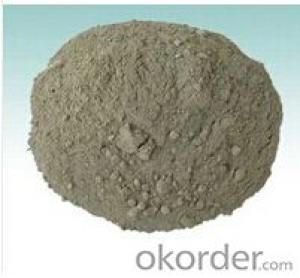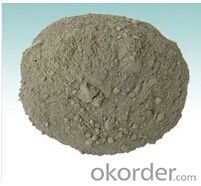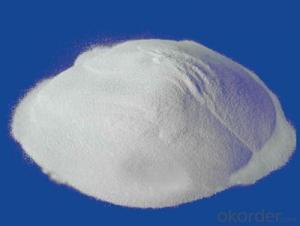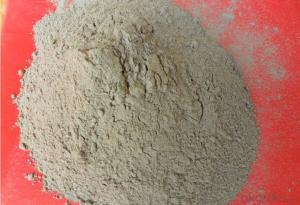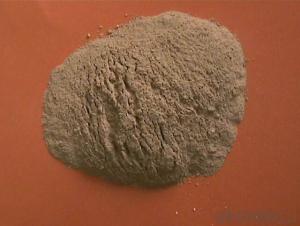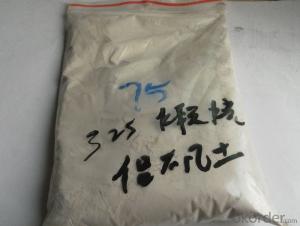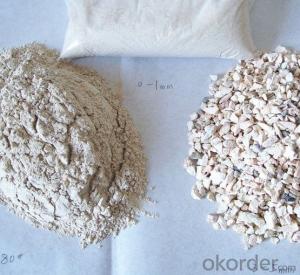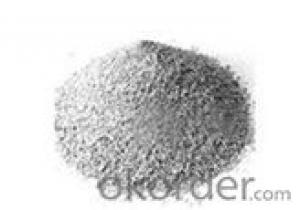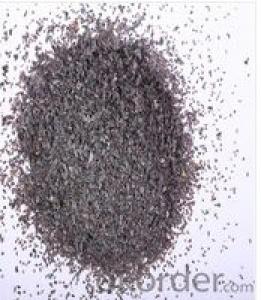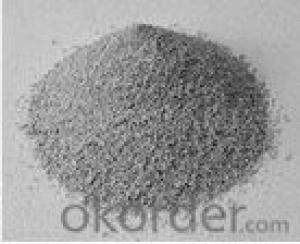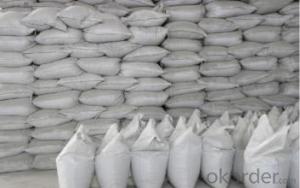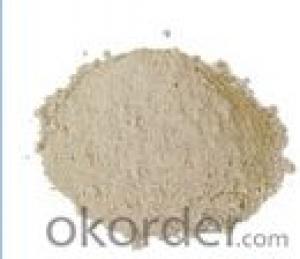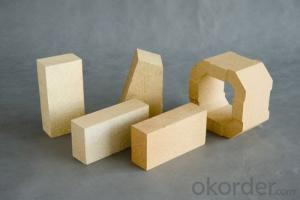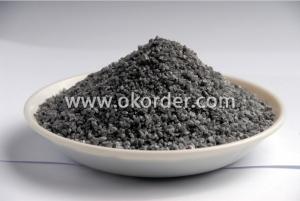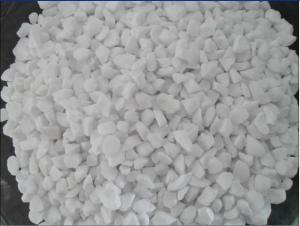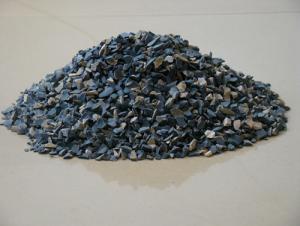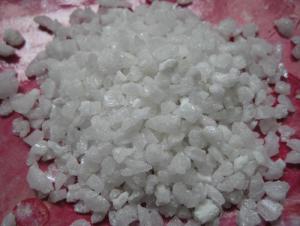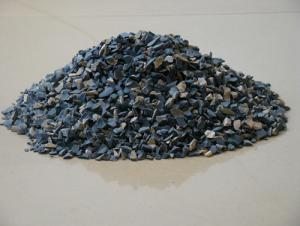High Strength, High Alumina Castable - Raw Materials for Refractory
- Loading Port:
- China Main Port
- Payment Terms:
- TT OR LC
- Min Order Qty:
- -
- Supply Capability:
- -
OKorder Service Pledge
OKorder Financial Service
You Might Also Like
Specifications
High Alumina Castable Refractory
high density, good strength, high refractoriness
professional supplier
Main functions:
(1) As there is high temperature, corrosion resistance, high strength properties, it poured with steel sliding gate, smelting rare metals, special alloys, ceramics, iron-smelting furnace of the lining (walls and tubes); physical and chemical containers , spark plugs, heat-resistant anti-oxidation coating.
(2) Due to high hardness, wear resistance, high strength characteristics, in the chemical system, used for a variety of reaction vessels and pipelines, chemical pump parts; to do mechanical parts, various molds, such as the Roberts mold, extrusion die nozzle pencil lead, etc.; do tool, die grinding, bullet-proof material, the human body joints, sealing ring mold.
(3) Corundum heat preservation material , such as lightweight corundum brick, corundum hollow ball and fiber products, widely used in a variety of high-temperature kiln furnace walls and roof, both high temperature-resistantance and heat-preservation.
Purpose | Specification | Chemical composition(%) | Magnetic material content(%) | ||||
Al2O3 | Fe2O3 | SiO2 | TiO2 | ||||
For abrasive | F | 4#—80# | 95.0 Min | 0.3 Max | 1.5 Max | 3.0 Max | 0.05 Max |
90#—150# | 95.0 Min | 0.03 Max | |||||
180#—240# | 94.0 Min | 0.3 Max | 1.5 Max | 3.5 Max | 0.02 Max | ||
P | 8#—80# | 95.0 Min | 0.2 Max | 1.2 Max | 3.0 Max | 0.05 Max | |
100#—150# | 95.0 Min | 0.03 Max | |||||
180#—220# | 94.0 Min | 0.3 Max | 1.5 Max | 3.5 Max | 0.02 Max | ||
W | 1#-63# | 94.0 Max | 0.5 Max | 1.8 Max | 4.0 Max | — | |
For refractory | Size sand | 0-1mm | 95 Min | 0.3 Max | 1.5 Max | 3.0 Max | — |
0-25mm | 95 Min | 0.3 Max | 1.5Max | 3.0Max | — | ||
Fine powder | 180#-0 | 93.5 Min | 0.5 Max | 1.5 Max | 3.5 Max | — | |
FACTORY:

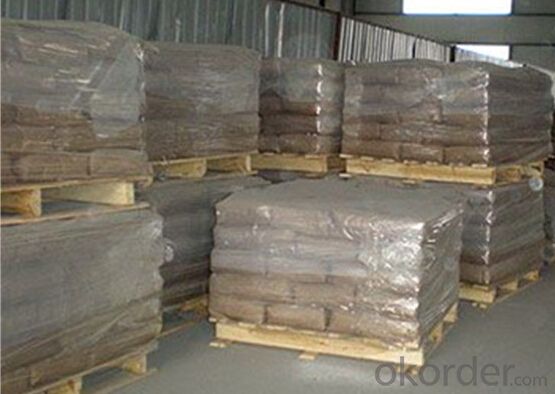
- Q: How much modulus is used as refractories material of sodium silicate.
- Storage and use are very convenient, especially for mechanized and the evenly refractory material and the sodium silicatemodulus is generally...2. transportation. The appearance of product is pure white. Instant powdered sodium silicate, also known as instant sodium metasilicate.4 to 3, in powder form, automation. in the range of 3, hydrated sodium silicate
- Q: How to distinguish the fire resistant level of the rubber and plastic thermal insulation material?
- Level A of non-combustible insulation materials are: W W inorganic active wall insulation materials, cement foam insulation board, glass beads of insulation mortar, rock wool board, glass wool board and foam ceramics, ect. Th e level A is non-combustible material, characterized with low density, low thermal conductivity, high bearing capacity, convenient construction, economy and durablity, and widely used as the thermal insulation materials in hot pipes, thermal equipment and other pipe-line equipment and industrial architectures, and as the thermal insulation, heat insulation and sound-absorbing materials in industrial and civil building envelope. Because of its good thermal stability, it is more used as fire-resistant protective coating material of steel structure.
- Q: I wanna ask about the building insulation materials fire rating?
- In China, the main external insulation materials are divided into level A, level B1, level B2 and level B3. According to the current "Combustion Performance Classification Method of Building Materials", level A thermal insulation material is incombustible material and inorganic insulation material. However, there are few level A thermal insulation material on the current market, only glass wool, rock wool board, foam glass and vitrified micro bead. However, compared with level A insulation material, the organic insulation materials are popular in the market. Level B insulation material can be divided into three levels, level B1 is flame-retardant, level B2 is flammable, and level B3 is flammable. Level B1 nonflammable thermal insulation material is determined by the fire endurance of the material, in addition, different parts of material is divided differently! More common is EPS / XPS insulation boards which have added flame retardant through special treatment. B2 level of combustible insulation materials, common to EPS expanded polystyrene foam insulation board and XPS board, that is, we often say that the general board. The ignition point of this material is very low, and it will release a large amounts of harmful gases in the combustion process. level B3 flammable insulation material is a kind of thermal insulation material which mainly made of polyphenyl foamed. Since this material is highly flammable, it has been eliminated. Civil construction insulation materials, popular building insulation materials in China's current market are mainly made by three organic foam, such as EPS (molded polystyrene board), XPS (extruded polystyrene board) and PU (polyurethane)
- Q: What type of firebrick does TZ-3 represent?
- It is the standard brick.
- Q: How to distinguish between class A fire resistant door and class B fire resistant door from appearance ? What are the differences between the two refractories? Thank you !
- First, the materials are the same. But the thickness of grade A and grade B fire doors is different juding from their appearances. Grade A :50. Grade B:45. Added question: Do you refer to steel fire door?
- Q: Is there requirement for radiation indicator in refractory?
- All refractories have no radiated harm to environment, so there is no requirement. From the elemental analysis, magnesite. I do not know it is helpful to you. But for refractory rwa material, any chemical element is radiated, including silicon?dioxide; If they are radioactive. From the use analysis, such as bauxite, do not have use value.
- Q: What needs to be noted when choosing and using blast furnace fireproof materials? Who knows?
- there are different temperatures in various parts of the blast furnace, thus using different types of refractory.
- Q: What refractory material does cupola lining use?
- In order to improve the service life of the lower wall and the bottom leather, dense and high alumina brick can be used for masonry. The front furnace is composed of the bottom, the wall and the top. The top of the furnace is vaulted or hanging flat roof. The front furnace body is usually made of clay brick and high alumina brick, and the bottom work floor is rammed with ramming material. The material is the same as that of cupola furnace. The bridge and the front guard taphole, slag hole and other parts due to erosion by high temperature molten iron and slag erosion, lower service life, frequent repairs. Large blast furnace adopts hot blast or oxygen enriched blast, which has higher temperature and higher production capacity... The damage is faster, and it is hard to maintain production by using clay brick or high alumina brick. Should be used aluminum, carbon or corundum refractory silicon carbide castables pouring or tamping, so that the integrity of good, high strength, corrosion resistance, and therefore significantly improved service life, generally up to one year or so. Refractory materials, including chimneys and spark traps, are used in other parts of the cupola. The chimney and the cupola shaft directly connected with the shell made of steel plate, lined with ordinary clay brick, can also be used ordinary refractory castable pouring. The chimney is provided with a furnace heat exchanger, which can preheat the air to 300~500 DEG C, and the spark collector is used for catching the hot coke and dust particles brought out in the flue gas. The chimney at the top of the reflector (cover) by plate welding, can also be used to cast iron, its lining refractory coating or spraying paint.
- Q: Is the refractory reached British BS standard and used for cables in China at present ceramic silicone rubber?
- The texture should be designed according to the British relevant BS standard; crosslinked polyethylene or ethylene propylene rubber under 6600V to 19000 / 33000V is not necessarily ceramic silicone. The rated voltages of a small amount of smoke and corrosive gases from 3800 & # 47 when the BS 7835-2000 is affected by fire.
- Q: What are the uses of refractory materials of glass furnace?
- crown--high-purity silica bricks; wall--melting end 41# fused zirconia corundum bricks with no shrinkages(41% of zirconium, similarly hereinafter), cooling end 33# fused zirconia corundum bricks with no shrinkages; bottom--33# fused zirconia corundum bricks(with shrinkages); breastwork--33# fused zirconia corundum bricks(with shrinkages); port--33# fused zirconia corundum bricks(with shrinkages); regenerator chamber--the upper part is for magnesite-chrome bricks, the bottom part is for high-duty fireclay bricks; checker--the upper part is for high purity magnesia bricks, and the bottom part is for magnesite-chrome bricks; flue--clay bricks.
Send your message to us
High Strength, High Alumina Castable - Raw Materials for Refractory
- Loading Port:
- China Main Port
- Payment Terms:
- TT OR LC
- Min Order Qty:
- -
- Supply Capability:
- -
OKorder Service Pledge
OKorder Financial Service
Similar products
Hot products
Hot Searches
Related keywords
